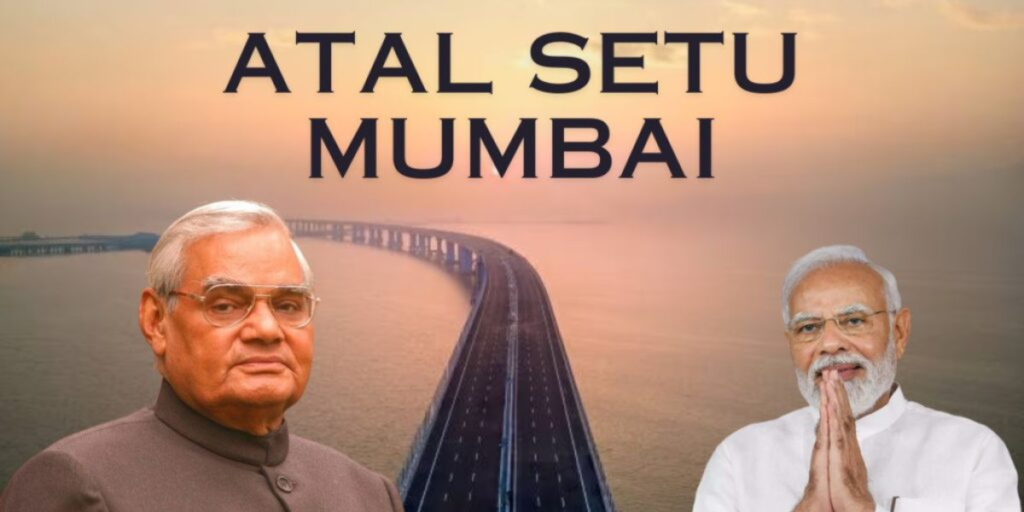India’s urban mobility landscape underwent a transformative shift as Prime Minister Narendra Modi inaugurated the Atal Setu on a historic day in Mumbai. Officially named the Shri Atal Bihari Vajpayee Trans Harbour Link (MTHL), this engineering marvel stands as the longest sea bridge in the country, stretching over the Arabian Sea from Sewri in Mumbai to Chirle in Raigad. With a total length of 21.8 kilometers, including 16.5 kilometers over the sea and 5.5 kilometers on land, the Atal Setu promises to revolutionize travel, significantly reducing the commute time between Mumbai and Navi Mumbai.

Table of Contents
The Vision Behind Atal Setu:

The conception of the Atal Setu dates back six decades, but it finally materialized as part of Prime Minister Modi’s vision for enhanced urban mobility. The groundbreaking ceremony for this six-lane access-controlled elevated road bridge took place in December 2016, setting in motion a project aimed at not just reducing travel time but also improving connectivity and accessibility to key airports in the region.
Construction and Cost:
The ambitious project of building the Atal Setu came at a considerable cost, with an investment exceeding Rs 17,840 crore. The construction process, spanning several years, involved intricate engineering and design to ensure the bridge’s safety, durability, and environmental sustainability. The result is a structure that stands as a testament to modern engineering prowess.

Environmental Considerations:
Recognizing the importance of environmental sustainability, the Atal Setu incorporates features that go beyond mere functionality. The bridge includes river circulation rings designed to mitigate sound and vibrations, earning recognition from the Bombay Natural History Society for its environmental considerations. This acknowledgment underscores the commitment to balancing infrastructural development with ecological preservation.
Connectivity and Economic Impact:
The Atal Setu is more than just a bridge; it is a lifeline for improved connectivity. By linking Sewri to Chirle, the bridge significantly reduces travel time between Mumbai and Navi Mumbai. Additionally, it enhances access to the Mumbai and Navi Mumbai International Airports, marking a crucial development for the region’s economic and infrastructural growth.
Economic forecasts suggest that the Atal Setu will have a substantial impact on connectivity between the Mumbai Port and Jawaharlal Nehru Port, potentially reducing the distance between Panvel and Sewri by 15 kilometers. This enhanced connectivity is poised to stimulate economic activities and trade, making the bridge a vital component of the region’s economic landscape.
Toll System and Traffic Management:

To fund the maintenance and operation of the Atal Setu, a toll system has been implemented. Passenger cars will be subject to a one-way toll of Rs 250, with varying rates for return journeys and frequent travelers. Cars returning via the sea bridge will incur a toll of Rs 375, while monthly and daily passes are available at Rs 625 and Rs 12,500, respectively. The toll system aims to strike a balance between funding the bridge’s sustainability and ensuring affordability for regular commuters.
Safety measures are paramount on the Atal Setu, and to this end, an advanced traffic management system has been integrated. This system, employing cutting-edge technology, ensures the safety and efficiency of the bridge by monitoring and managing traffic flow.
Usage Restrictions and Speed Limits:
While the Atal Setu is a symbol of progress, certain restrictions have been put in place to ensure its optimal functioning and safety. Motorcycles, autorickshaws, and tractors are not permitted on the sea bridge. Four-wheelers are required to adhere to a speed limit of 100 km per hour, with additional speed restrictions of 40 km/h during the bridge’s ascent and descent.
Conclusion:

The inauguration of the Atal Setu marks a significant milestone in India’s infrastructural development. Beyond its title as the longest sea bridge, the Atal Setu represents a triumph of vision, engineering, and sustainability. As Mumbai and Navi Mumbai embrace the benefits of reduced travel time, improved connectivity, and enhanced economic prospects, the Atal Setu stands as a testament to the nation’s commitment to progress. The bridge not only spans physical distances but also bridges the gap between the past and the future, symbolizing a new era of urban mobility in India.

